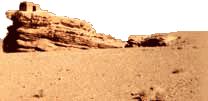 |
|||||
Jordan: History and Culture
The Hashemite Kingdom of Jordan is a relatively modern creation, carved out of the desert in the aftermath of the great Arab Revolt (ended 1918) and the destruction of the Ottoman Empire. Its eastern and southern borders are wholly artificial; arbitrary lines, drawn in the sand, by the then colonial powers. Its King is only the fourth generation of his family to occupy the Hashemite throne. The Kingdom itself may be young, but the people who inhabit it have, like their ruling family, an immensely long and distinguished past. The land that is now Jordan lies in a position of great strategic and geographic importance, a crossroads where the Spice and Silk Routes from eastern Asia to the Mediterranean met the north-south axis of the trade routes from Turkey and Syria down to Arabia and Yemen. Jordan was home to the earliest Stone Age settled farming communities; to the great Bronze Age fortified cities whose distant memory comes down to us through the later Iron Age texts of the Bible; to the warring successors of Alexander the Great; to the Roman legions of Trajan and later Emperors; and most importantly, because of the unique position they occupy in world architectural history, to the Nabataeans. The remains of all these civilisations lie scattered around the deserts and mountains of Jordan, and can be found by anyone with open eyes and an enquiring mind.
We can still visit the villages where Stone Age man lived in the arid mountains of south Jordan in tiny, interlocking stone-built houses. When their descendants discovered the art of copper-smelting we enter the age known as Chalcolithic. The early inhabitants of Jordan created strange, two-headed cultic plaster statues, some of which are now in the Smithsonian and some in the Amman Museum, whose ghostly, bitumen-rimmed eyes stare back at us across nine thousand years. Then, in the Bronze Age, fortified cities emerged in the desolate landscape south of the Dead Sea; these are the Cities of the Plain referred to in the Bible, neighbours to the vanished cities of Sodom and Gomorrah.
Moses himself died in Moab, on Mount Nebo, where the Jordanian government has with great generosity allowed the Franciscan order to take custody of the sacred site. Later biblical history tells us of King David's sinful love for Bathsheba, whose husband Uriah the Hittite he disposed of by sending him to lead the troops in the siege of Rabboth Ammon - modern-day Amman. Today we can see the remains of the Iron Age fortifications on which Uriah was killed. Iron Age Jordan was a land of small kingdoms, sometimes feuding with each other and sometimes with their Israelite neighbours, with constant sheep and cattle raiding, yet with a literate elite accustomed to luxury goods; dyed cloths, ivory, fine stone-built mansions. This culture fell into the orbit of the Assyrians, who were kept at bay by the payment of tribute, but whose influence in terms of artistic and architectural style lingered for centuries.
These Arab people, whose origins still remain mysterious, built their wealth upon the guardianship of the caravan routes and on the ingenious management of water in desert areas. Even today, Bedouin herders in Jordan's Hisma desert rely on Nabataean cisterns for their water supply and have carefully preserved and repaired these ancient structures over two thousand years. The Romans conquered the Nabataeans, but after the conquest came a period of friendly co-existence, and the Nabataean culture and kingdom flourished unimpeded by Rome.
The coup de grâce was an earthquake which devastated their capital, Petra, in 363 AD. Jordan became a poor backwater of the Byzantine Empire until the Muslim conquests of the 7th century, when it enjoyed a cultural revival under the 'Umayyad caliphs. Their desert hunting lodges and bathhouses covered in glorious painted frescos of dancing animals and playing children testify to a free and vibrant artistic spirit. But after less than a century the Abbasid family plotted a successful coup against the 'Umayyads from their base at Humeima, southern Jordan, and with the collapse of 'Umayyad power Jordan entered into a kind of Dark Age, from which it only partially emerged under the rule of the Ottomans.
Freedom came when the Ottoman Empire was shattered by defeat in the First World War, during which Jordan became known to westerners as the setting for the exploits of Lawrence of Arabia. To Jordanians, though, T.E. Lawrence is merely a footnote in the story of the great Arab Revolt. The Revolt marks a milestone in their history as it led to the establishment of the modern Kingdom. The Emir Abdullah of the Hashemite family, descendant of the Prophet Mohammed, was offered the land of Transjordan, as it was then known, and a new Arab nation was born. Today, this kingdom is known, rather like Britain, for "punching above its weight" in political terms. Partly due to the extraordinary personality of its late King, Hussein bin Talal, it has a reputation for moderation and peace brokering in the Middle East. Now King Abdullah rules over an Islamic state which protects its Christian minority, which has peacefully absorbed some three million Palestinian refugees over the past thirty years. Jordan remains an oasis of peace in a troubled region. |
|||||


|
|---|
 Most people come to Jordan to see the famous Nabataean city of Petra which is a
marvel. It is possible to visit Petra dozens of times and still come away
astonished by the beauty and variety of the site, but Petra is only a fraction
of what Jordan has to offer. Jordan's antiquities cover a vast timescale, as
well as a vast landscape, and the more spectacular and interpretable sites were
built some 8,500 years ago.
Most people come to Jordan to see the famous Nabataean city of Petra which is a
marvel. It is possible to visit Petra dozens of times and still come away
astonished by the beauty and variety of the site, but Petra is only a fraction
of what Jordan has to offer. Jordan's antiquities cover a vast timescale, as
well as a vast landscape, and the more spectacular and interpretable sites were
built some 8,500 years ago. Jordan enters into the realms of written history with the Iron Age kingdoms of Ammon, Moab and Edom,
ancient enemies (and occasional allies) of the emerging Jewish nation. Moses
passed through Edom and Moab on his way to the Promised Land, and his brother
Aaron was said to have died on a mountaintop overlooking Petra, where there is a
shrine of great antiquity, sacred to Muslims, Jews and Christians (too sacred,
in fact, to be excavated).
Jordan enters into the realms of written history with the Iron Age kingdoms of Ammon, Moab and Edom,
ancient enemies (and occasional allies) of the emerging Jewish nation. Moses
passed through Edom and Moab on his way to the Promised Land, and his brother
Aaron was said to have died on a mountaintop overlooking Petra, where there is a
shrine of great antiquity, sacred to Muslims, Jews and Christians (too sacred,
in fact, to be excavated). The other great artistic and architectural influence on Jordan in antiquity was, of course, that
of Greece. Alexander the Great's Near Eastern successors ensured the spread of
Hellenism and this, combined with indigenous orientalism, produced the unique
fusion of styles created by the Nabataeans.
The other great artistic and architectural influence on Jordan in antiquity was, of course, that
of Greece. Alexander the Great's Near Eastern successors ensured the spread of
Hellenism and this, combined with indigenous orientalism, produced the unique
fusion of styles created by the Nabataeans. The Nabataeans vanished back into the desert and out of the pages of history at
some period in the 4th and 5th centuries AD, their civilisation having fallen
victim to the twin catastrophes of economic decline and natural disaster.
The Nabataeans vanished back into the desert and out of the pages of history at
some period in the 4th and 5th centuries AD, their civilisation having fallen
victim to the twin catastrophes of economic decline and natural disaster.  Limited prosperity came to Jordan under the Ottoman Turks as the great Moslem
pilgrimage, the Haj, passed through the land on the way south to Mecca. The
Turks built a string of Haj forts - protected caravanserais - for the pilgrims,
but the Arabs suffered under an oppressive burden of taxes.
Limited prosperity came to Jordan under the Ottoman Turks as the great Moslem
pilgrimage, the Haj, passed through the land on the way south to Mecca. The
Turks built a string of Haj forts - protected caravanserais - for the pilgrims,
but the Arabs suffered under an oppressive burden of taxes.